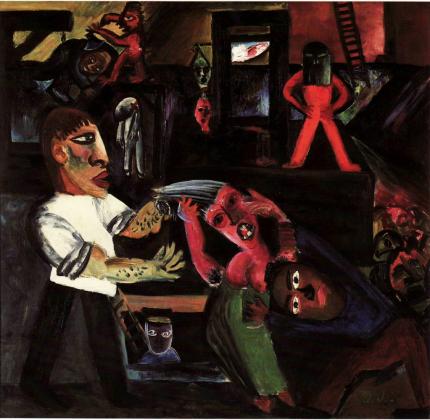-
-
-
Par MMaxi le 30 March 2007 à 19:44

Das jüngste Gericht ( The Last Judgement), as depicted by
Dresden Secession artist Walter Jacob is a powerful contemporary
updating of a traditional image, complete with a bold portrait of Dix on the left,
yanking a woman by the hair as she resists being pulled in to an abyss .
MMaxi
-
Par MMaxi le 30 March 2007 à 19:32

Dix's Die Skatspieler ( The Skat Players ) of 1920 shows three mutilated veterans, former officers,
playing cards in a gaslit pub. So deformed are they by their injuries that they are forced to play
with prophetic hands or with their mouths or feet. Little is left of these maimed figures,
yet even the fragments - the iron Cross, the carefully parted hair - recall an earlier world.
Collage elements, such as the newspapers on the walls, heighten the sense of realism.
MMaxi
-
Par MMaxi le 25 March 2007 à 16:20

Conrad Felixmüller, Opfer der Not / Für das Hilfswerk der IAH ( Victim of Privation/For the Relief Organization of the IAH ), 1924
-
Par MMaxi le 25 March 2007 à 16:14

Wilhelm Rudolph, Helft am Werk der IAH ( Help the Work of the IAH ), 1924
-
-
Par MMaxi le 25 March 2007 à 15:52

Will Küpper, Nach Dem Krieg ( After The War ) 1919 and Will Küpper, Streichhòlzer ( Matches, Matches ), 1919
Some of the most Compelling posters were distributed by the anti-Bolshevik groups. They used Images of gorillas and vultures depicted in Gaudy, horrific yellows and reds to frighten the public to attention. These artists sought a coalition, a united Germany, as illustrated in Klein Arbeiter,
Bürger. Bauern. Soldaten (Workers. Citizens. Farmers. Soldiers;
In addiction to making posters, many artists created covers for widely circulated broadsheets, pamphlets, and periodicals.
Between 1918 and 1925 different literary journals of varying longevity were published throughout Germany; most of these were liberal to radical in bias. Of these fifty-three were founded after 1918 and folded before 1925." The periodicals were able to respond instantly to current events. Their titles reflect the youth and vigor of their makers.
Guenther discusses many of the lesser-known journals in this essay.
From Berlin, Bielefeld, Darmstadt, Dresden, Dusseldorf, Hamburg, Hannover, Heidelberg, Munich, and Saarbrucken came periodicals with titles such a Die Aktion,
Der Anbruch,( The new beginning ) Die Dachstube ( The attic Room ), Feuer ( Fire ), Kündung ( Herald ), Menschen, Die Rote Erde( The Red Hearth ) Die Sichel ( The Sickle ), Das Tribunal ( The Tribunal ) Der Wurf
( The Venture ), and Der Ziegelbrenner ( Brick-Maker ).
Together they form an important part of the history of postwar
German Expressionism, for it was in these periodicals that the artists, writes, publishers, and poets were able to join together most effectively to sound their cry for a new society and for a new role for creative peolple.
MMaxi
-
Par MMaxi le 22 March 2007 à 22:10

Käthe Schmidt Kollwitz (July 8, 1867 – April 22, 1945) was a German painter, printmaker, and sculptor whose work offered an eloquent and often searing account of the human condition in the first half of the 20th century. Her empathy for the less fortunate, expressed most famously through the graphic means of drawing, etching, lithography, and woodcut, embraced the victims of poverty, hunger, and war. Initially her work was grounded in Naturalism, and later took on Expressionistic qualities.
After her return Kollwitz continued to exhibit her work, but was impressed by the work of younger compatriots--the Expressionists and Bauhaus--and resolved to simplify her means of expression. Subsequent works such as Runover, 1910, and Self-Portrait, 1912, show this new direction. She also continued to work on sculpture.
Kollwitz lost her youngest son Peter on the battlefield in World War I in October of 1914, prompting a prolonged depression. By the end of the year she had made drawings for a monument to Peter and his fallen comrades; she destroyed the monument in 1919, and began again in 1925. The memorial, entitled The Grieving Parents, was finally completed and placed in the Belgian cemetery of Roggevelde in 1932. Later, when Peter's grave was moved to the nearby Vladslo, the statues were also moved.
In 1917, on her fiftieth birthday, the galleries of Paul Cassirer provided a retrospective exhibition of one hundred and fifty drawings by Kollwitz.
Kollwitz was a committed socialist and pacifist, who was eventually attracted to communism; her political and social sympathies found expression in the "memorial sheet for Karl Liebknecht", and in her involvement with the Arbeitsrat für Kunst, a part of the Social Democratic Party government in the first few weeks after the war. As the war wound down and a nationalistic appeal was made for old men and children to join the fighting, Kollwitz implored in a published statement:
"There has been enough of dying! Let not another man fall!"
-
MMaxi on the move








